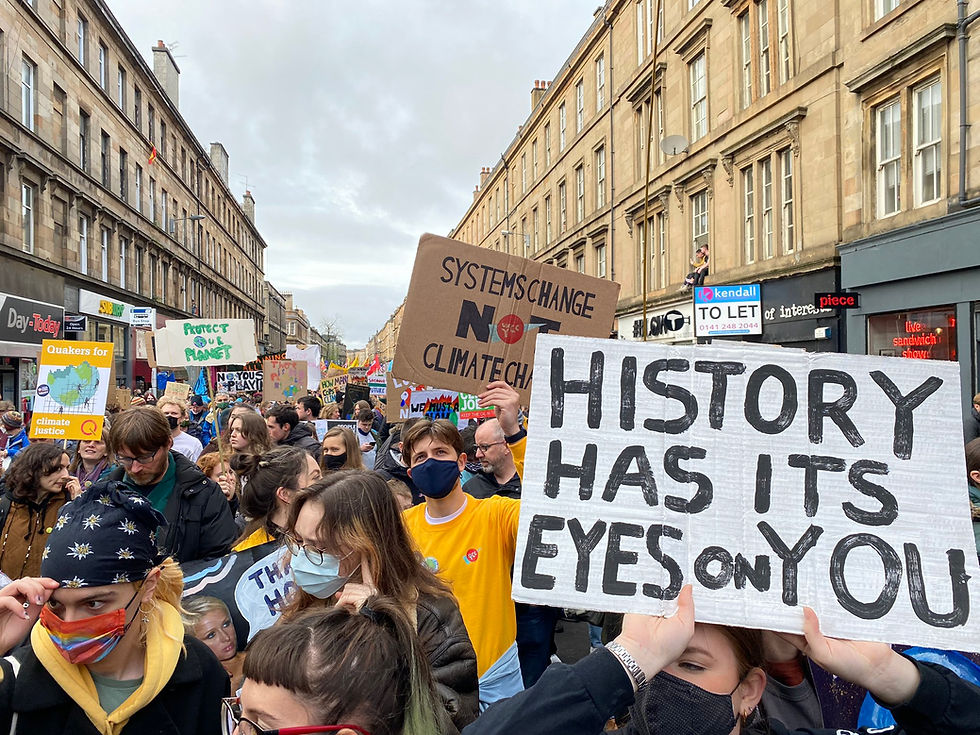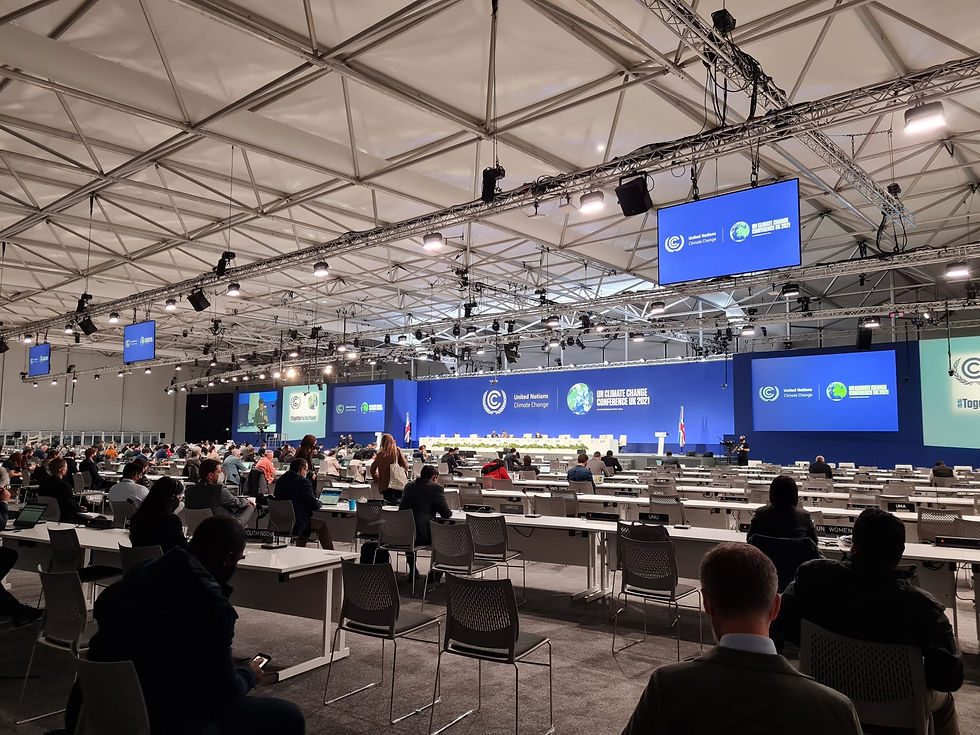COP26: A success or failure for the UK Government?
- UKYCC

- Nov 14, 2021
- 6 min read
Updated: Nov 15, 2021
LUCY JORDAN
After two, tumultuous years of anticipation, and the arrival of more than 40,000 people upon the streets of Glasgow, COP26 finally drew to an end on Saturday, following hard-fought negotiations by nations into the night.
However, what did the Glasgow Climate Pact actually manage to agree upon, and was it enough to vitally mitigate emissions and support frontline communities? Spoiler alert - not really - but let’s take a look and understand more about what really went on.

UKYCC join thousands of others to march for climate justice in the streets of Glasgow
Coal, Trees and EV’s
Prior to the COP, the UK government set out 4 key targets they wished to fulfil; phasing out coal, ending deforestation, transitioning to electric vehicles, and keeping 1.5 alive.
The first - ending the use of coal within energy production - was one of the initial issues addressed within the conference, with many countries signing an agreement to transition away from coal in the coming decades.
However, in the final negotiation text, the call for the "phase-out of unabated coal power” was watered down at the last minute by India, trading the text instead for a coal “phase-down”.
This offered a considerable blow to the conference in its final moments, with the language now, essentially, allowing for countries to slow their transition away from coal with the aid of false-solutions, such as offsetting.

The image displays the ‘Cairn Gorm’ Plenary Room, where much of the high-level negotiating took place at COP26.
The text did, however, include ending “inefficient fossil fuel subsidies” and “recognizing the need for support towards a just transition” - an inclusion which surprised many, with previous mentions of fossil fuels having been heavily blocked by Global North nations.
The inclusion of ‘inefficient’ subsidies was added by nations who may need to continue to rely on such subsidies to protect the most vulnerable in the population from sky-rocketing power prices. The question will be, however, how the text is interpreted by richer nations, and whether such clarification is manipulated by these states to continue fossil fuel support.
The conference also announced a plethora of nations committing to ending deforestation by 2030, including countries such as Brazil, Indonesia, Russia, and the Democratic Republic of Congo. This meant that the agreement accounted for many of the world’s most vulnerable rainforests, including the Amazon, the Congo Basin, and the Siberian Taiga, providing some hope for the protection of these vital ecosystems.
Not so promising, however, was the commitment by nations to transition to 100% zero-emission sales of new cars by 2035, with the US, China, Germany and France - four of the world’s largest automotive economies - all missing from this register. Following their failure to commit to the agreement, many car manufacturers, including Toyota, Honda and BMW, swiftly followed suit, meaning the agreement made only a small dent in global car production.
Keeping 1.5 Alive
Finally, to the key focus of the COP26 presidency: “keeping 1.5 alive”. Did it ultimately happen?
In short, no. Nowhere near, in fact. Current national targets are still set to cause emissions to rise by 13% by 2030, as opposed to decrease by 45%, as the IPCC’s most recent report recommends. This means that warming is predicted to exceed 2.4 degrees celsius by the end of this century, threatening devastating impacts for the world’s ecosystems and vulnerable communities.
In light of this, the final text “requests” parties to return to COP27 with new and ambitious targets, which align more closely with the 1.5 degrees target, enabling the government to still technically say that 1.5 is still alive - with the truth being far from it.

Climate activists hosting an action in COP26’s Blue Zone entranceway, calling to “Keep 1.5 Alive”.
Adaptation and Loss & Damage
Two other key outcomes from the conference include the expanded inclusion of both Adaptation and Loss & Damage within the final text, with both issues remaining a key sticking point for many Global South nations who accused richer states of dismissing these issues within the talks.
Adaptation refers to the funding and support offered to vulnerable countries expected to feel the impacts of climate change in coming years, whereas Loss and Damage applies to those impacts that global communities are already experiencing now.
Funding provided by Global North nations was promised to reach $100 billion a year by 2020, with $20 billion of this set aside to fund adaptation. The UN Adaptation Gap Report, however, estimated funding required for adaptation standing between $140-300 billion, highlighting the enormous gap nations currently need to bridge to effectively resource nations set to be most affected.
Funding, moreover, for mitigation and adaptation collectively remained at only $80 billion, with the final text “urging” countries to fully deliver on this target and “at least double” their 2019 commitment to adaptation by 2025.

A light installation drawing attention to Loss and Damage outside COP26's Blue Zone exit.
Similarly, the text went much further in acknowledging the issue of Loss and Damage than before, however, current funding remains at only £2 million for Loss and Damage, as put forward by Scotland in recent weeks, whilst current estimates place the funding required in the trillions of dollars.
To put it into perspective, following devastating floods in its western region, Germany invested $35 billion in aid to help affected communities recover from the event during the summer, rendering Scotland’s lone pledge a mere drop in the ocean of that required by impacted communities.
What was promising, however, was among the first recognition of climate debt owed to frontline communities by a Global North nation, with Scotland’s First Minister, Nicola Sturgeon, emphasising Loss and Damage funding not as an act of “charity” but rather “reparation”.
This is a small, but key, first step in Global North nations acknowledging the violence they have committed against frontline communities via climate impacts, with discussion of reparations and climate debt carrying an understanding of accountability on the part of polluting nations. Most Global North countries fear, however, engaging with such language, due to the claims of wrongdoing and damages that will then be held against them.
Fossil Fuel Representation
Finally, COP26 was the first in history to include no fossil-fuel related sponsors on their roster, taking some step towards dealing with Conflict of Interests within the COP and dismantling vested interests.
However, as the negotiation progressed, it came to light that still hundreds of negotiators hailed from fossil fuel-related backgrounds, comprising the largest delegation of the summit and undermining the negotiations’ progress.
Was COP26 a success?
The big question, therefore, remains: was COP26 successful in achieving what it set out to do?
In short, again, no. But these talks remain increasingly complex.
If we consider the 1.5 degrees target still alive, then it is, at best, on serious life support, with the world now reliant on governments to do what they have never managed to do before; implement ambitious and truly effective targets that they can achieve justly in the coming years.
To say this is a mountainous task, therefore, is an understatement, and to say that the presidency will be disappointed is to water down our language almost as much as the final text.
Moreover, the UK government is still giving the go-ahead to a number of fossil fuel projects, including providing licensing for the Cambo oil field in Scotland’s North Sea, and funding for a mega natural-gas project in Mozambique. COP26 could, in this way, be seen to have been doomed from the start, never truly able to provide an example of climate leadership with government still providing funding to the very projects the conference was hoping to mitigate.


UKYCC and other young people march on the streets of Glasgow for climate action
We did witness, however, collective civil society turn out like never before, with young people, especially, arriving in force from all corners of Britain and beyond, and sounding loud amidst the media noise and frenzy.
From the People’s Summit hosted by the COP26 Coalition, to the 100,000 people that took to Glasgow’s streets for climate justice - marking the city’s largest march in history - Glasgow was abound with creativity, intensity, and determination, drawing upon from knowledge and experience from all around the world.
Moving forward, whether the outcomes from COP26 become a success or not depends, therefore, on the willingness of governments to listen to these voices that lined the streets; to draw from their ideas and insight, and to find a way to channel the ambition and justice we see on the ground.
How do you feel COP26 went and what do you want to see now following the negotiations’ end? Message us on Twitter (@ukycc), Facebook (@UKYCC) or Instagram(@_ukycc_) to share your thoughts and follow along for more discussion on the outcomes of COP26.




Comments